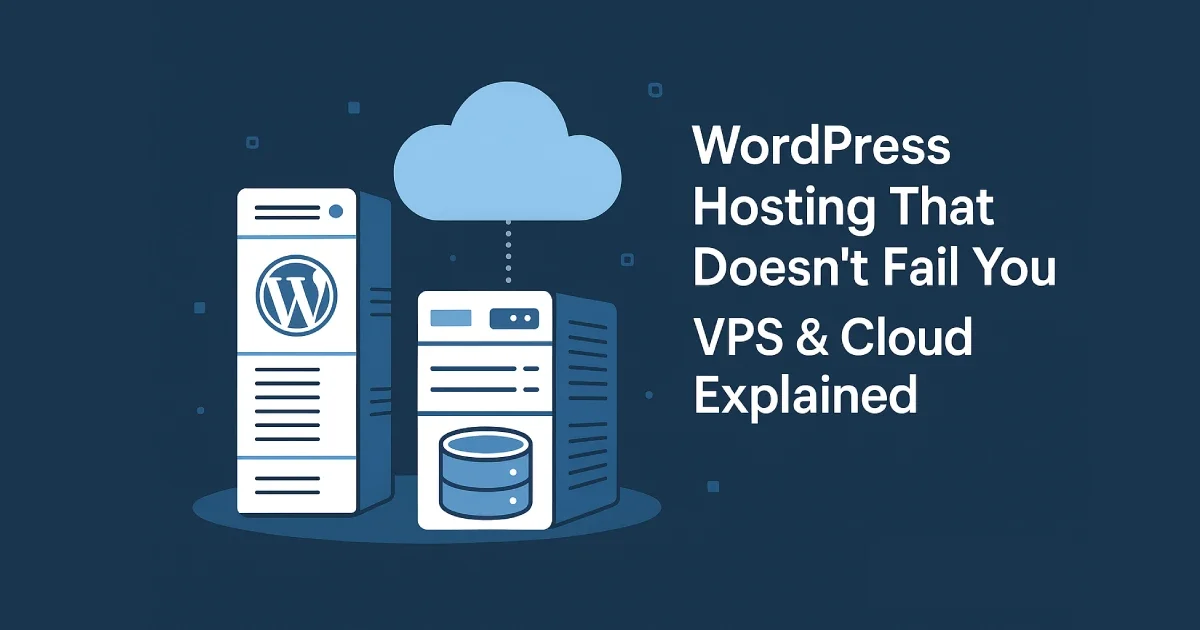
Most WordPress issues — slow load times, unexpected downtime, random errors, crashing during traffic spikes — have nothing to do with your theme, plugins, or design.
They come from bad hosting.
Shared hosting is cheap, but it puts you in the same room as hundreds (sometimes thousands) of other websites. When someone else’s site gets traffic or hacked, your site suffers. That’s why serious businesses move to VPS and Cloud hosting — hosting that actually doesn’t fail you.
At Wisegigs.eu, we build high-performance WordPress environments using VPS and cloud servers optimized for speed, scalability, and security. This guide breaks down the difference, what you should choose, and how to configure it the right way.
Explore Wisegigs hosting solutions
1. The Problem With Shared Hosting (Why Sites Fail)
Shared hosting is popular because it’s cheap — but the tradeoff is performance, stability, and control.
Typical shared hosting issues:
Slow server response time
Random downtime
Limited CPU/RAM (shared with strangers)
No control over PHP workers or caching
Poor security isolation
Slow support response times
When performance matters, shared hosting becomes a bottleneck.
This is where VPS and cloud hosting become the reliable upgrade path.
What are the disadvantages of shared hosting?
2. What is VPS Hosting? (The Smart Upgrade)
A Virtual Private Server (VPS) gives you a portion of a powerful server with dedicated resources.
Why VPS hosting works well for WordPress
Dedicated CPU + RAM → predictable speed
Full root access → custom server tuning
Install your own stack → NGINX, Redis, PHP versions
Stronger isolation from other users
Better for SEO and Core Web Vitals
Wisegigs deploys VPS servers on providers like:
Hetzner
DigitalOcean
These offer stable NVMe storage, fast CPUs, and excellent uptime.
3. What is Cloud Hosting? (The Enterprise Solution)
Cloud hosting runs your site on multiple virtual servers instead of one machine.
If one node goes down or becomes overloaded, traffic instantly moves to another.
Why Cloud Hosting Doesn’t Fail
High availability (HA)
Automatic failover
Horizontal scaling
Multi-region support
Extremely reliable under heavy load
Cloud hosting is ideal for:
WooCommerce stores
Learning platforms (LMS)
Enterprise WordPress
Viral websites
Multi-site or high-traffic blogs
4. VPS vs Cloud Hosting: Which One Should You Choose?
Choose VPS if:
You want the best performance for the price
Your site gets consistent but moderate traffic
You need room to grow
You want full control of your server environment
Choose Cloud hosting if:
You need zero downtime
You expect traffic spikes (campaigns, ads, viral content)
You run an eCommerce site where uptime = revenue
You want redundancy and automatic failover
At Wisegigs, we select VPS or Cloud based on:
Traffic patterns
Performance requirements
Security levels
Budget
Application complexity
Why WordPress Performs Better on VPS & Cloud
WordPress is dynamic — it generates pages on the fly.
This puts load on the server.
On VPS/Cloud, you get:
More PHP workers
Faster database queries
Full Redis support
Better CPU scheduling
Optimized server caching
Low-latency storage (NVMe SSD)
This leads to:
Faster load times
More stable uptime
Better SEO rankings
Higher ecommerce conversion rates
6. Wisegigs’ Recommended Server Stack (Battle-Tested)
We build every environment using a proven stack:
Server Layer
NGINX or LiteSpeed web server
PHP 8.1 or 8.2 with OPcache
Redis object caching
MariaDB or MySQL 8
HTTP/2 or HTTP/3 (QUIC)
Security Layer
Fail2Ban
UFW or Firewalld
Isolated PHP pools
Automatic security updates
Malware scanning
Performance Layer
Redis persistent caching
Cloudflare CDN + WAF
FastCGI cache rules
Brotli compression
NVMe SSD storage
This combination gives you sub-100ms server response times and stable performance under load.
7. VPS & Cloud Resource Recommendations
Basic WordPress Sites
1 vCPU
2GB RAM
20GB NVMe
LiteSpeed or NGINX
Business / Agency Sites
2–4 vCPU
4–8GB RAM
40–80GB NVMe
Redis + Cloudflare
WooCommerce, LMS, High Traffic
4–8 vCPU
8–16GB RAM
80–200GB NVMe
Redis
Cloudflare Enterprise
Cloud hosting recommended
Wisegigs actively monitors resource usage and upgrades before bottlenecks happen.
8. VPS & Cloud Hardening Essentials
Strong SSH keys (no passwords)
Fail2Ban anti-bruteforce
Web application firewall (Cloudflare WAF)
Enforce HTTPS
Disable XML-RPC
Limit admin access by IP (optional)
Daily automated backups
14–30 day backup retention
Hardening is non-negotiable for production WordPress sites.
9. Deployment Checklist (Wisegigs Standard)
Before we launch a WordPress site, we ensure:
✅ VPS/Cloud deployed with optimal region
✅ NGINX or LiteSpeed configured
✅ PHP 8.x optimized
✅ Redis object cache running
✅ Cloudflare CDN connected
✅ Database optimized
✅ Backups enabled
✅ Monitoring & uptime tracking active
✅ Security hardening complete
This ensures reliability and performance — without surprises.
Conclusion
Shared hosting fails because it’s built to be cheap, not reliable.
VPS and Cloud hosting give your WordPress site what it actually needs: performance, control, uptime, and room to grow.
At Wisegigs.eu, we engineer VPS and Cloud environments that deliver consistent speed, high availability, and enterprise-grade stability — so your website doesn’t fail when you need it most.
👉 Ready for a hosting upgrade that won’t let you down? Contact us today
